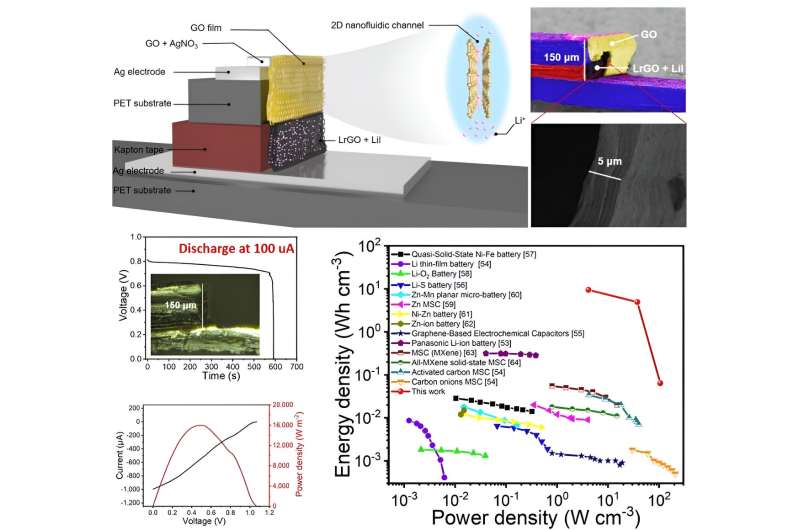A strategy to realize vertical iontronic energy storage via osmotic effects and electrode redox reactions
In recent years, engineers have been trying to identify new technologies to sustainably generate and store energy. One promising solution leverages the energy produced by osmosis when two fluids with a different salt concentration meet, such as when a freshwater body (e.g., a river) flows into a saltwater body (e.g., the sea).
The energy produced by differences in salt concentration, known as salinity gradient or osmotic energy, has proved very difficult to turn into portable electrical energy in a practical and scalable way. Utilizing this process to power consumer electronics, such as smartwatches and smartbands, thus so far appears impracticable.
Researchers at the Chinese Academy of Sciences, Tsinghua University and Hong Kong University of Science and Technology recently introduced a new method that could help to effectively store iontronic energy based on osmotic effects. This method, outlined in Nature Energy, allowed them to leverage osmotic effects and electrode redox reactions to realize a vertical iontronic energy storage system.
“Almost 10 years ago, we observed an interesting scientific phenomenon, namely that the fast transported ions in water inside graphene oxide (GO) can generate decent energy,” Di Wei, co-author of the paper, told Tech Xplore.
“This was the first attempt to provide a very safe energy source that enables new applications including building a foldable energy source on paper and platform for futuristic wearable electronics. Later, further studies attempted to scale up its power via the mathematical fractal design concept as a printing pattern, which unveiled the mechanism using silver (Ag) electrodes.”
The recent study by Wei and his collaborators builds on these previous research efforts, drawing inspiration from both the efficient ion-transport dynamics of GO’s 2D nanofluidic channels and the carefully tailored interfacial redox reactions. In their paper, the team introduced a new approach to store iontronic energy based on osmotic effects, thus enabling the realization of innovative, renewable, ultrathin, and safe power sources.
“Reverse electrodialysis (RED) is one of the most common methods used for osmotic energy conversion and many investigations have focused on ion-selective membranes to increase the ion transport and lower the internal resistance,” Wei explained. “There is a competitive relationship between the selectivity and permeability of the ion-selective membrane, and the ideal optimized thickness is supposed to be less than 1 μm, which is fragile and difficult to obtain.”
To create their solid-state iontronic energy storage device, Wei and his colleagues first sprayed various GO-based inks onto charge collectors, using an ultrasonic spray-coating system, and then dried these onto a PET substrate. As the inks were drying, the 2D nanofluidic channels of GO started forming.

“The electrode gap of the device, covered by GO, is equal to the thickness of the ion-selective membrane in a conventional osmotic power source,” Wei said. “We devised a vertical strategy using the edge of a PET substrate and Kapton film, which offered the capability to scale down the ion-transport distance (equivalent to a decrease in the thickness of the ion-selective membrane).”
More information:
Feiyao Yang et al, Vertical iontronic energy storage based on osmotic effects and electrode redox reactions, Nature Energy (2024). DOI: 10.1038/s41560-023-01431-4
Puguang Peng et al, Integratable Paper‐Based Iontronic Power Source for All‐In‐One Disposable Electronics, Advanced Energy Materials (2023). DOI: 10.1002/aenm.202302360
© 2024 Science X Network
Citation:
A strategy to realize vertical iontronic energy storage via osmotic effects and electrode redox reactions (2024, January 29)
retrieved 30 January 2024
from https://techxplore.com/news/2024-01-strategy-vertical-iontronic-energy-storage.html
This document is subject to copyright. Apart from any fair dealing for the purpose of private study or research, no
part may be reproduced without the written permission. The content is provided for information purposes only.

Comments are closed